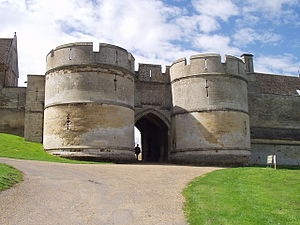Rockingham Castle
| Rockingham Castle | |
|---|---|
| Part of Northamptonshire | |
| Corby, England | |
 The main gateway at Rockingham Castle | |
| Type | Enclosure castle |
| Height | 10 metres (33 ft) |
| Site information | |
| Owner | Saunders Watson family |
| Condition | Renovated |
| Site history | |
| Built | 11th Century |
| In use | Private |
| Materials | Limestone Sandstone |
| Events | English Civil War |
Rockingham Castle is a former royal castle and hunting lodge in Rockingham Forest[1] a mile to the north of Corby, Northamptonshire.
History
11th - 14th centuries
The site on which the castle stands has been used in the Iron Age, Roman period and by the invading Saxons also used by the Normans, Tudors and also used in the Medieval Period. This is because its position on elevated ground provides clear views of the Welland Valley from a strong defensible location.
William the Conqueror ordered the construction of a wooden Motte and Bailey at Rockingham in the 11th century shortly after the Norman Invasion of Britain. Within three decades, William II replaced it with a stone castle. A stone keep was added to the large motte and the outer bailey was enclosed by a curtain wall. The castle was then used as a Royal retreat throughout the Norman and Plantagenet periods. Nearby Rockingham Forest was especially good for hunting wild boar and deer.
In 1270 Henry III strengthened the castle with the addition of a twin D-tower gatehouse. But less than a century later Edward III became the last monarch to visit the castle while it was possessed by The Crown.
15th - 21st centuries

By the late 15th century Rockingham Castle had fallen into disrepair. Sir Edward Watson[2] (founder of the Watson Family dynasty) acquired the lease of the castle from Henry VIII. Parts of the castle were subsequently replaced with a Tudor house with gardens. The former royal castle became a hunting lodge for the nobility.[3] Watson's grandson Lewis Watson acquired the freehold of the castle and lands from the crown. Watson was successively a knight, baronet and baron.[4]
In the 1640s Rockingham was garrisoned by troops loyal to Charles I during the English Civil War. Several small skirmishes were fought with Parliamentary forces. In 1643 Rockingham was captured by Parliamentarian general Henry Grey, 1st Earl of Stamford and Lewis Watson temporarily forced to leave. Its remaining walls were slighted in 1646. In the latter 17th and 18th centuries, Rockingham returned to being a civil residence.
Lewis' grandson, also Lewis, was created Earl of Rockingham in 1714, a barony that was extinguished with the death of the 3rd baron in 1746. The estate then passed to his cousin Thomas Watson-Wentworth, who was created the 1st Marquess Rockingham later that year. When Charles Watson-Wentworth, 2nd Marquess of Rockingham died in 1782, the estate among others passed to the son of his sister, William Fitzwilliam, 4th Earl Fitzwilliam. The castle underwent further restoration in the late 19th century.
Today the castle remains the private home of the Saunders-Watson family.
Location

Rockingham Castle is often stated as being in the county of Leicestershire. This mistake arises due to Rockingham having a Market Harborough postal address, even though it borders directly onto the town of Corby in Northamptonshire. Rockingham village is part of, and is administered by Corby Borough Council.
The Castle overlooks the villages of Rockingham and Caldecott and enjoys good views over the Welland Valley. Now privately owned, it is open to the public on certain days.
Rockingham Castle was a popular haunt of writer Charles Dickens who was a great friend of Richard and Lavinia Watson, ancestors of the current family. The Castle is arguably the inspiration for Chesney Wold in one of his greatest works, Bleak House.
Rockingham Castle takes its name from the village of Rockingham, where the Castle is located. Rockingham Forest was also named after Rockingham village, during the time of William the Conqueror, because of the Castle's importance as a Royal retreat.
A cricket pitch lies within the grounds of the castle and is home to Old Eastonians Cricket Club.
Filming
Rockingham Castle was used as the set for the BBC English Civil War period drama By the Sword Divided. In the TV series "Arnescote Castle" was the home of the Royalist Lacey family. It also featured in the film Top Secret! which starred Val Kilmer.
See also
References
- ^ Furtado, Peter; Geddes, Candida; Harris, Nathaniel; Harrison, Hazel; Pettit, Paul (1987). Guide to Castles in Britain. Hamlyn – Ordnance Survey. p. 138. ISBN 9780600558699.
{{cite book}}:|work=ignored (help) - ^ Furtado, Peter; Geddes, Candida; Harris, Nathaniel; Harrison, Hazel; Pettit, Paul (1987). Guide to Castles in Britain. Hamlyn – Ordnance Survey. p. 138. ISBN 9780600558699.
{{cite book}}:|work=ignored (help) - ^ "Rockingham Castle - Tudors". Rockingham Castle. Retrieved 2011-01-27.
- ^ George Edward Cokayne Complete Baronetage, Vol. 1 1900
Further reading
- Hartshorne, Chales Henry (1845). Archaeological Journal. 1: 356–378.
{{cite journal}}:|chapter=ignored (help); Missing or empty|title=(help)
External links
- Official website
- Photos of Rockingham Castle and surrounding area on geograph
- Map sources for Rockingham Castle
